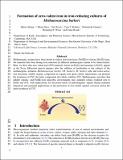Formation of Zerovalent Iron in Iron-Reducing Cultures of Methanosarcina barkeri
Author(s)
Shang, Haitao; Daye, Mirna; Sivan, Orit; Sciascia Borlina, Caue; Tamura, Nobumichi; Weiss, Benjamin P.; Bosak, Tanja; ... Show more Show less
DownloadAccepted version (932.4Kb)
Open Access Policy
Open Access Policy
Creative Commons Attribution-Noncommercial-Share Alike
Terms of use
Metadata
Show full item recordAbstract
© 2020 American Chemical Society. Methanogenic archaea have been shown to reduce iron from ferric [Fe(III)] to ferrous [Fe(II)] state, but minerals that form during iron reduction by different methanogens remain to be characterized. Here, we show that zerovalent iron (ZVI) minerals, ferrite [α-Fe(0)] and austenite [γ-Fe(0)], appear in the X-ray diffraction spectra minutes after the addition of ferrihydrite to the cultures of a methanogenic archaeon, Methanosarcina barkeri (M. barkeri). M. barkeri cells and redox-active, nonenzymatic soluble organic compounds in organic-rich spent culture supernatants can promote the formation of ZVI; the latter compounds also likely stabilize ZVI. Methanogenic microbes that inhabit organic- and Fe(III)-rich anaerobic environments may similarly reduce Fe(III) to Fe(II) and ZVI, with implications for the preservation of paleomagnetic signals during sediment diagenesis and potential applications in the protection of iron metals against corrosion and in the green synthesis of ZVI.
Date issued
2020Department
Massachusetts Institute of Technology. Department of Earth, Atmospheric, and Planetary SciencesJournal
Environmental Science and Technology
Publisher
American Chemical Society (ACS)